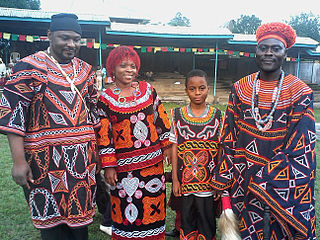Zizilivakan, also known as Fali of Jilbu and Ulan Mazhilvən, is a Chadic language spoken in Cameroon in Far North Province and neighboring Nigeria. It is one of several in the area that go by the name Fali.

The Northwest Region, or North-West Region is one of ten regions of Cameroon. Its regional capital is Bamenda. The Northwest Region was part of the Southern Cameroons, found in the western highlands of Cameroon. It is bordered to the southwest by the Southwest Region, to the south by the West Region, to the east by the Adamawa Region, and to the north by Nigeria. Various Ambazonian nationalist and separatist factions regard the region as being distinct as a polity from Cameroon.
Massa is a Chadic language spoken in southern Chad and northern Cameroon by the Masa people. It has approximately 200,000 speakers.
Bulu is a Bantu language of the Bulu people of Cameroon. The language had 174,000 native speakers in 1982, with some 800,000 second language speakers in 1991. Its dialects include Bene, Yelinda, Yembana, Yengono, and Zaman. Bulu was formerly used by colonial and missionary groups as a lingua franca in the region for commercial, educational, and religious purposes, though it is today becoming less frequent in those spheres.
The Bamileke languages are a group of Eastern Grassfields languages spoken by the Bamileke people in the Western High Plateau of Cameroon.

Batié is a town and commune in the Hauts Plateaux Division in western Cameroon. It is located at latitude 5.283333 and longitude 10.28333. Batié is known for its association football club Sable FC, the "San San Boys", named after the sand production in this mountainous region. The climate in Batié is very mild. Rainy season typically lasts from March through October. Dry season begins in November and goes into March of the following year.
Afade (Afaɗə) is an Afro-Asiatic language spoken in eastern Nigeria and northwestern Cameroon.
Psikye is an Afro-Asiatic language spoken in northern Cameroon and eastern Nigeria. Varieties include Psikyɛ and Zləngə. Blench (2006) classifies it as a dialect of Kamwe.
North Mofu is an Afro-Asiatic language spoken in northern Cameroon. Dialects are Douroun and Wazan.
Gude is an Afro-Asiatic language spoken in Nigeria in Adamawa State in Mubi LGA and in Borno State in Askira-Uba LGA. It is also spoken in neighboring Cameroon. Different dialects are spoken in Nigeria and Cameroon.
Jimi (Djimi), also known as Jimjimən and 'Um Falin, is a Chadic language spoken in Cameroon in Far North Province on the Nigerian border in and around Bourrha. Dialects are Djimi, Jimo, Malabu, Wadi, and Zumo.
The Eastern Grassfields languages, spoken in the Western High Plateau of Cameroon, are a branch of the Grassfields languages including Bamun, Yamba and Bamileke.

Baham is the seat of the Department of Hauts-Plateaux, in the Western Province of Cameroon. It also constitutes a traditional Bamileke chiefdom.
Chamba Leko is one of two languages spoken by the Chamba people, the other being Chamba Daka. It is a member of the Leko branch of Savanna languages, and is spoken across the northern Nigerian–Cameroonian border.
Kogo, also referred to as Bakoko and Basoo, is a Bantu language of Cameroon. North and South Kogo are as distinct from each other as they are from Basaa; they might be considered three dialects of a single language.
The Koma language is a language cluster belonging to the Duru branch of Savannas languages of Cameroon. Blench (2004) includes three varieties separated in Ethnologue, Koma Ndera, Gɨmne, and Gɨmnɨme; within Koma Ndera, speakers of the marginal dialects, Gomnome and Ndera, can scarcely understand one another, though both understand the central dialect, Gomme.
Limbum is a Grassfields language of Cameroon, with a small number of speakers in Nigeria. It is used as a trade language by some, but is primarily the mother tongue of the Wimbum people, who live in Donga-Mantung division of the Northwest Region, at the top of the Ring Road.
Iyive, also referred to as Uive, Yiive, Ndir, Asumbos, is a severely endangered Bantoid language spoken in Nigeria and Cameroon. The ethnic group defined by use of this language is the Ndir.

Mundum (Bamundum) is a Grassfields Bantu language spoken in Cameroon. It is closely related to Mankon and Mendankwe-Nkwen; along with Mankon, it is called Ngemba. There are two dialects, Anyang and Mberewi.

Mankon is a Grassfields language spoken in Cameroon. It is closely related to Mundum and Mendankwe-Nkwen. Along with Mundum, it is called Ngemba. There are several distinct dialects: Mankunge (Ngemba), Nsongwa, Shomba, Mbutu (Bambutu), Njong (Banjong), Bagangu (Akum) and Alatening.





